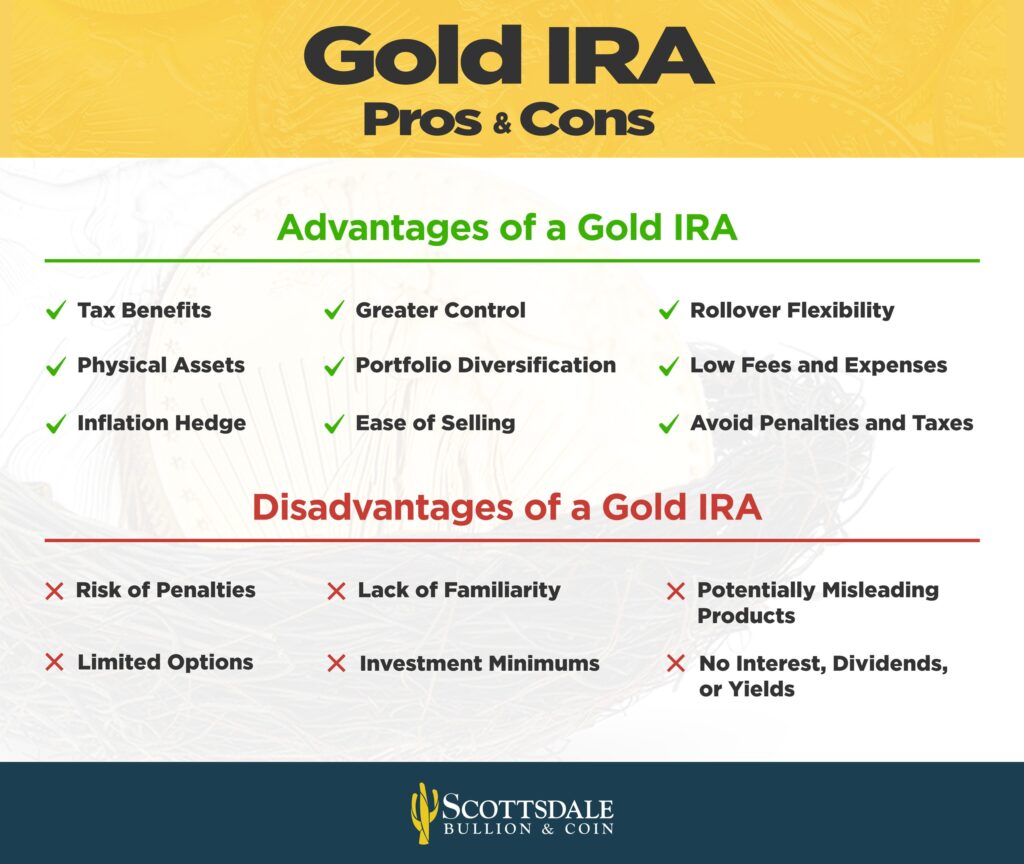Gold IRAs unlock unparalleled advantages not achievable through conventional retirement plans. Savvy investors utilize this lesser-known investment account to achieve proper diversification for increased protection from high inflation, stock market volatility, Fed incompetence, banking uncertainty, and other economic pressures. As with any investment, a gold IRA comes with a mix of advantages and considerations. Understanding the nuances of this retirement plan puts investors in a better position to effectively protect their wealth.
A gold IRA, also known as a gold-backed IRA or precious metals IRA, is a self-directed Individual Retirement Account (IRA) that gives account holders greater autonomy and flexibility compared to more mainstream retirement plans. It maintains the tax advantages of a standard IRA while permitting investors to hold various tangible assets for increased diversification and protection. As the name suggests, a self-directed gold IRA is set up to primarily hold gold and other precious metals including silver, palladium, and platinum.
📚 Suggested Reading: How a Precious Metals IRA Works
When judging a traditional vs. gold IRA, investors should shift their focus to the types of permitted investments. Both accounts offer a method for putting tax-deferred dollars towards investment vehicles for optimized growth before retirement. However, a traditional IRA is exclusively for standard assets such as stocks, bonds, and ETFs. A gold IRA makes it possible for investors to include physical precious metal assets within their nest egg.
What Are the Pros and Cons of a Gold IRA?
A gold IRA can be an effective way to hedge against inflation to protect your retirement savings from inevitable economic downturns. However, understanding the full spectrum of benefits and considerations of any retirement plan is crucial to making wise investment decisions.
Advantages of a Gold IRA (The Pros):
- Tax Benefits
Similar to a traditional IRA, a gold-backed IRA offers various tax incentives in the form of tax-deferred growth and potential deductions in taxable income for IRA contributions. For tax years 2024 and 2025, investors can move up to $7,000 (or $8,000 if you’re over 50) of pre-taxed dollars into their gold IRA each year. Furthermore, every dollar you contribute is one dollar you don’t have to pay taxes on that year.
- Physical Assets
The starkest difference between a traditional and physical gold IRA is the form of permitted investments. Most notably, the latter allows investments in physical assets while the former restricts investors to paper assets. Physical gold assets offer a range of advantages over their paper counterparts including independence from market volatility due to their inherent value. Plus, as a tangible investment, physical gold assets can’t be wiped out with the push of a button. Remember, if you can’t hold it, you don’t really own it.
- Inflation Hedge
For centuries, prudent investors have relied on gold to protect against inflation. When relying solely on fiat-backed paper assets, investors are at the whims of market volatility. Through a physical gold IRA, you have access to a wide array of precious metals assets with inherent value to protect against the corrosive effects of inflation. To put things into perspective, the US dollar has lost 99% of its value when compared to gold over the past 90 years.
- Greater Control
IRS rules aren’t the only limitations placed on traditional IRAs. Investors are also subject to the investment restrictions placed by the company or financial institution sponsoring the account. A gold IRA grants investors considerably more control over the types of assets held in their retirement accounts.
While the IRS has rules on which types of precious metals products you can buy, a gold IRA still gives you greater freedom and control than a standard individual retirement account. You can invest in popular bullion coins such as American Eagle Gold Coins or Canadian Maple Leaf Silver Coins, as well as gold bullion bars and proof coins. We’ve created a full list of IRA-approved precious metals to simplify the selection process.
- Portfolio Diversification
The goal of portfolio diversification is to spread out your investments among a range of different asset classes to protect against unpredictable and unavoidable market volatility. A physical gold IRA helps investors achieve this goal by opening the door to physical precious metal assets while maintaining the tax-advantaged status of a retirement account. Interestingly, the IRS doesn’t limit the number of IRA accounts you can hold which allows for plenty of diversification into a spectrum of paper and physical assets.
- Ease of Selling
Gold, even as a physical asset, is highly liquid. It enjoys relatively consistent demand when compared to other assets regardless of market conditions, making it easy for investors to convert their assets into cash when needed. Selling physical assets held within a gold IRA is no different than with a traditional plan. Simply contact your precious metals advisor, and they’ll handle the liquidation. It usually only takes a few days to complete the transaction.
- Rollover Flexibility
Another considerable advantage of a gold IRA is its rollover flexibility. The IRS makes it relatively easy to convert your current retirement plans into a self-directed IRA in precious metals without incurring any early withdrawal or other tax penalties. This is great news for individuals with old employee-sponsored 401(k)s or investors searching for greater control over their retirement accounts. Through a proper rollover, your nest egg can maintain its tax-advantaged momentum while expanding its diversification.
Here’s a full list of the various accounts eligible for a gold IRA rollover:
- ✓ Traditional IRA
- ✓ Simple IRA
- ✓ Roth IRA
- ✓ Thrift Savings Plan (TSP)
- ✓ 401(k)
- ✓ 403(b)
- ✓ 457 Plan
- Low Fees and Expenses
Setting up a gold IRA isn’t free, but it is relatively inexpensive. Generally, there are only three fees involved when opening an account including a one-time initiation fee along with annual custodian fees and storage fees. The storage expenses are the only costs unique to a gold IRA as you’ll encounter the first two with any retirement account. The specific amount you’ll pay will vary depending on the Trust company you choose. However, the annual expenses range between $160 and $200, which can be minimal compared to a lifelong investment.
💰 Gold IRA Costs: Read more about how much money you need to start a gold IRA.
- Avoid Penalties and Taxes
Many investors prefer to use their IRA to purchase physical metals to diversify their nest egg. Unfortunately, using a distribution from a traditional IRA to buy gold or silver comes with harsh tax implications. If you’re looking for a way to take ownership of physical metals without paying taxes or incurring penalties, a gold IRA may be the way to go. It allows you to use tax-deferred, retirement funds to directly purchase a diverse array of precious metals.
Disadvantages of a Gold IRA (The Cons)
- No Interest, Dividends, or Yields
While paper-backed assets offer returns in the form of interest, dividends, or yields, the physical assets held in a gold IRA offer no such perks. These benefits offered by some stocks and bonds aren’t without caveats, though. For example, dividends can dilute a company’s earnings and, as a result, a stockholder’s ROI. Furthermore, businesses maintain the right to decrease or completely suspend interest rates without warning. Despite offering these perks, investing in a gold IRA removes these uncertainties.
- Lack of Familiarity
Gold IRAs aren’t as popular as their mainstream IRA counterparts which means investors often struggle with knowing where to begin. Most traditional IRA providers don’t even know much about self-directed gold IRAs. A great way to speed up and simplify the process is to find a reputable precious metals IRA advisor who, along with a dedicated IRA Liaison, can support you throughout the whole process. If you’re completing a gold IRA rollover, you can expect the process to take between 1 and 3 weeks on average.
- Risk of Penalties
While a gold IRA technically expands your investment horizons, the IRS still restricts what kind of assets you can hold. There are limitations on types of metals, purity ratings, and more. Additionally, there are rules regarding storage, annual contributions, and withdrawals. Trying to set up and manage a gold IRA alone could expose you to IRS penalties or account closure altogether.
- Limited Options
The limitations placed by the IRS don’t just open investors up to potential penalties. These restrictions also decrease your investment options. Some popular bullion coins you might expect to be staples of a gold IRA aren’t allowed. Confusingly, the IRS even prevents investors from purchasing graded coins with tax-deferred dollars.
- Potentially Misleading Products
Unfortunately, the high stakes of gold IRA investments inevitably attract misleading precious metals dealers looking to take advantage of unwitting investors. Some coin dealers artificially boost the price of so-called dealer exclusive coins well beyond their inherent value. Others make empty promises of free gold or silver while burying the value of the “offer” somewhere else.
- Investment Minimums
Generally, traditional IRAs don’t have any minimum requirements, lowering the barrier of entry for investors. Gold IRAs, on the other hand, tend to demand relatively high minimums given the difficulty of setting up and maintaining the accounts. For example, a rollover from a mainstream retirement account to a gold IRA could require a $10,000 minimum while a direct purchase might require a $5,000 investment.
Is a Gold IRA a Good Idea for You?
A gold-backed IRA can be a prudent financial decision if it aligns with your investment goals. Understanding the ilk of investors who tend to seek out this unique retirement plan can shed some light on the decision. Generally, self-directed gold IRAs attract investors who:
- Aren’t comfortable betting their entire nest egg on the stock market.
- Haven’t seen a sufficient performance from their traditional IRA.
- Have a majority of their assets in a retirement account.
- Want to use IRA savings to purchase precious metals without paying taxes or incurring penalties.
The best way to determine if a physical gold IRA is right for you is by speaking with a dedicated precious metals advisor. These experts can answer your questions in depth and help you make an informed decision. You can contact one of our precious metals advisors by calling toll-free at 1-888-812-9892 or by using our live chat function.
Not ready to discuss this with an IRA advisor?
That’s okay! Learn more about precious metal IRAs at your own pace by reading these helpful guides:


